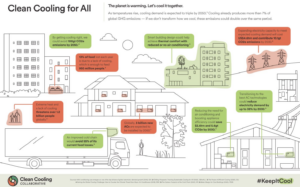July 4th, 2023
Via the Clean Cooling Collaborative, a summary of the challenges/opportunities ahead:
As temperatures rise, cooling demand is expected to triple by 2050. Cooling already produces more than 7% of global greenhouse gas emissions and if we don’t transform how we cool, these emissions could double over the same period.
However, if we get cooling right, we could avoid the emission of 100 GtCO2e by mid-century.
The cooling challenge:
> By 2050, an additional three billion new ACs are expected to be installed around the world.
> More than 1.2 billion people are at high risk from a lack of access to the cooling they need to stay healthy and safe.
> 13% of food produced is lost each year due to a lack of cold chain. This is enough to feed 950 million people.
> Expanding capacity to meet expected cooling demand will cost US$4.6trn between 2020 and 2030 and contribute 10.1 GtCO2 emissions.
> Without sustainable cooling solutions, countries aiming to achieve net zero by 2050 are likely to miss those targets by up to eight years.Keeping it cool:
> A global transition towards the best available technologies for all new AC units could reduce electricity demand by 29-38% by 2030.
> Installing more efficient AC equipment could save $0.9trn and 2.0 GtCO2 by 2030.
> Reducing the need for AC could increase savings to $3.5trn and 7.6 GtCO2 over the same period.
> Smart building design could help achieve thermal comfort without the need for electricity.
> An improved cold chain would avoid 55% of the food losses attributed to the current cold chain.
'Black Swans' are highly improbable events that come as a surprise, have major disruptive effects, and that are often rationalized after the fact as if they had been predictable to begin with. In our rapidly warming world, such events are occurring ever more frequently and include wildfires, floods, extreme heat, and drought.
'Green Shoots' is a term used to describe signs of economic recovery or positive data during a downturn. It references a period of growth and recovery, when plants start to show signs of health and life, and, therefore, has been employed as a metaphor for a recovering economy.
It is my hope that Black Swans / Green Shoots will help readers understand both climate-activated risk and opportunity so that you may invest in, advise, or lead organizations in the context of increasing pressures of global urbanization, resource scarcity, and perils relating to climate change. I believe that the tools of business and finance can help individuals, businesses, and global society make informed choices about who and what to protect, and I hope that this blog provides some insight into the policy and private sector tools used to assess investments in resilient reinforcement, response, or recovery.
